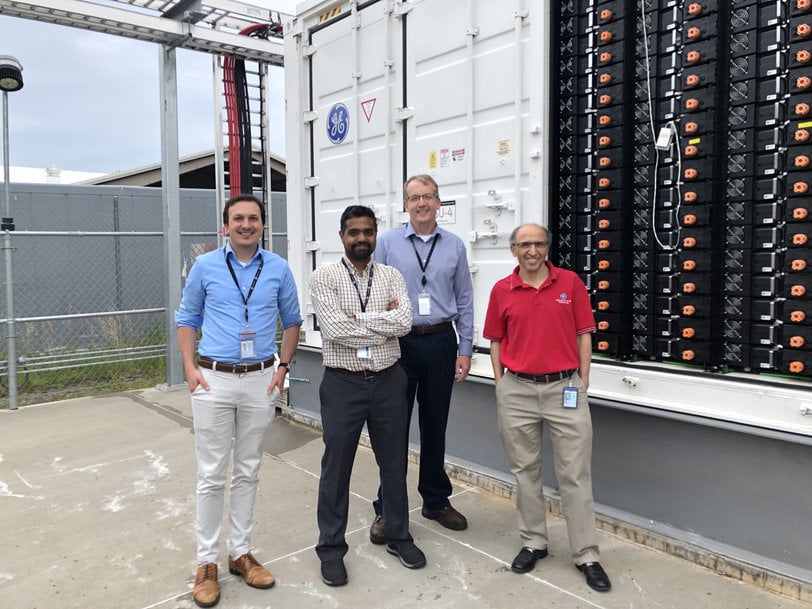GE Working on Behind-the-Meter Projects to Support PV Solar Integration into the Grid
GE Research and GE Renewable Energy are partnering with Sandia National Laboratories (SNL) on a $1.75M U.S. Department of Energy (DOE) Solar Energy Technology Office (SETO) project to design, build, and field test a 400kWh, 2-hour Commercial and Industrial (C&I) Battery Energy Storage System (BESS) to enable and support Behind the Meter (BTM) PV Solar integration into the grid.

- GE Research is also part of a second DOE project led by the University of Pittsburgh to enhance utilities visibility of BTM PV Solar generation
- Projects will promote the deployment of novel solutions that enhance grid resiliency and stability with high PV Solar penetration, and support commercial and industrial (C&I) customers in reducing their utility bills and maximizing utilization of their PV assets.
With the continued and unprecedented growth in BTM PV Solar installations, GE Research is working with DOE and its partners on two PV Solar and Storage projects that will allow consumers to fully utilize their PV assets, reduce their demand charges, and ensure continuity of service during grid disturbances and outages.
On the first project, GE Research and GE Renewable Energy are partnering with SNL to design, build, and test a 400kWh, 2-hour C&I BESS unit. The power conversion interface to PV, Batteries, and the Grid uses GE’s leading Silicon Carbide (SiC) power devices technology and grid forming controls. Grid Forming Inverters (GFMs) fitted with these advanced technologies and controls are essential in supporting and sustaining a more renewables-intensive grid.
GE scientists and engineers are also involved in a second project led by the University of Pittsburgh to help utilities gain more visibility into the level of BTM installed PV Solar generation by homes and businesses. Specifically, the GE team is developing analytics to provide utilities with reliable grid data to estimate PV Solar generation. Having greater visibility into this data will enable accurate grid forecasting as well as enhance grid stability and resiliency.
Ahmed Elasser, who is the Principal Investigator and leading the C&I BESS project, says that as BTM PV Solar deployments are growing, there is a need to provide storage assets to allow BTM customers to reduce their demand charges, self-consume their PV energy, and ensure service continuity during grid outages. These capabilities will be enabled by advanced technologies and controls.
Elasser says, “It’s exciting to see the unprecedented rates at which PV solar and other renewable resources are growing behind and in front of the meter. To support and sustain this growth, innovative hybrid solutions such as the 400kWh, 2-h BESS being developed under our DoE funded project, will play a key role in ensuring grid reliability and resiliency.”
Elasser explained that inverters are essentially the gateway for renewable resources to be efficiently interfaced and reliably distributed to the utility grid. As the number of renewable installations grows, the inverters are called upon to not only support the grid, but also to form the grid and coordinate with other inverters as well as other assets such as Energy Storage. For more on how grid-forming controls work, Click Here. And for more on GE’s energy storage solutions.
A reservoir of grid expertise. The GE Research team of Phil Hart, Naveenan Thiagarajan, Bill O’Rourke and Project Leader, Ahmed Elasser, stand in front of one of GE’s first Renewable Reservoir Energy storage units. It is a part of a larger 12MVA Future of Energy Test Facility on the Lab’s Niskayuna research campus.
This is where the team will design, build, and test its 400kWh, 2-h C&I Small Energy Reservoir to enable more resilient PV solar generation. This test facility hosts GE’s 4MWh Energy Reservoirs, its FLEXINVERTERTM PV and BESS inverters, and is also connected to a 250kW, 1500V PV Solar array for testing DC coupled PV Solar and Storage systems.
According to the Solar Energy Industries Association, PV Solar power has experienced an annual average growth rate of 33% over the past decade in the United States. Residential installations alone have grown from just ~422MW of installed capacity to more than ~24,000MW. Furthermore, the Association notes that PV Solar is increasingly being paired with BESS from residential to utility scale systems.
It estimates that the percentage of new BTM PV Solar systems fitted with BESS will grow to 29% of the total installed PV Solar capacity. In 2021, the number of PV Solar and Storage systems was just under 11% of the total installed PV Solar capacity.
The GE team will design, build, and test its 400kWh, 2-h C&I BESS unit at its 12MVA Energy Storage Test Facility, located on its Niskayuna campus. This test facility hosts GE’s 4MWh Energy Reservoirs, its FLEXINVERTER PV and BESS inverters, and is also connected to a 250kW, 1500V PV array for testing DC coupled Solar and Storage systems.
On the grid analytics project with the University of Pittsburgh, the end goal is to demonstrate grid analytics with the National Rural Electric Cooperative Association (NRECA). The main objective is to secure the quality of distribution data for distribution and transmission system operators and accurately identify BTM PV Solar assets to make them visible for grid planning and operation. NRECA represents more than 900 rural electric cooperatives that power more than 20 million customers over half of the entire U.S. landscape.
“We know that by driving new advances in sensing, analytics, and control technologies, we can bring more PV Solar online while maintaining and even enhancing grid stability and reliability,” “Working with NRECA will provide an excellent proving ground to demonstrate the enhanced value and visibility our grid analytics can bring toward supporting the transition to a more renewables intensive energy mix.” said, Honggang Wang, Principal Investigator at GE Research.
www.ge.com

